All cleaned up after live oak deluge
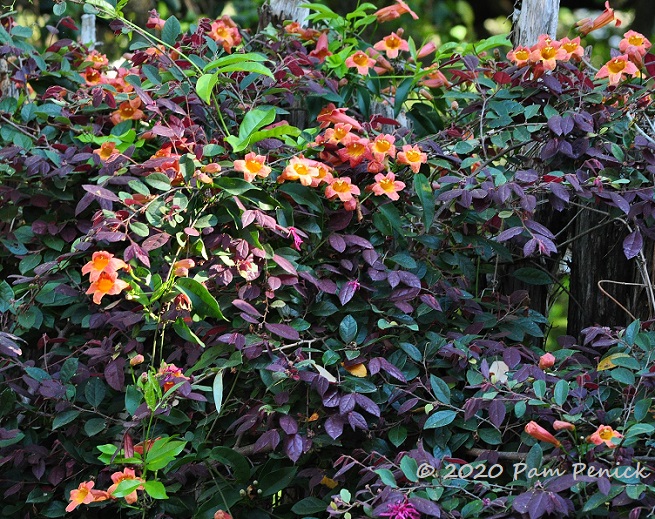
The garden reemerged last weekend, after copious raking and blowing and bagging, from the annual spring deluge of last season’s live oak leaves and subsequent pollen catkins. I ran around with the camera, capturing the gorgeousness of new flowers and fresh foliage, like this pretty combo of ‘Tangerine Beauty’ crossvine (Bignonia capreolata ‘Tangerine Beauty’) and wine-leaved ‘Sizzling Pink’ loropetalum (Loropetalum chinense) on the cedar fence in the backyard.
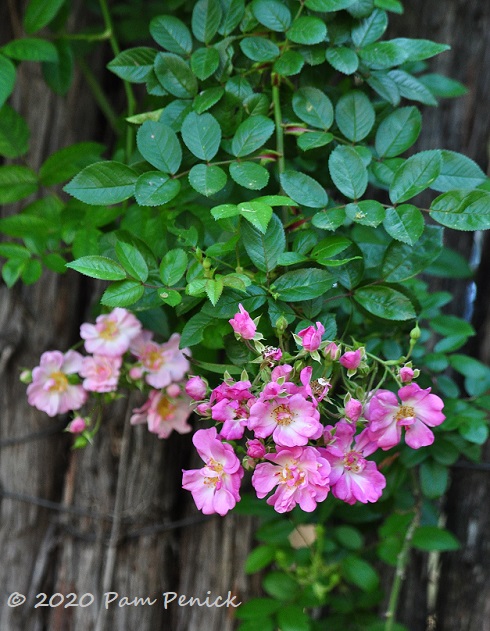
The center of the fence offers a rare sunny spot in my garden, for half the day anyway, and this year the Katrina rose (Rosa ‘Peggy Martin’) sports dozens of clusters of pink flowers.
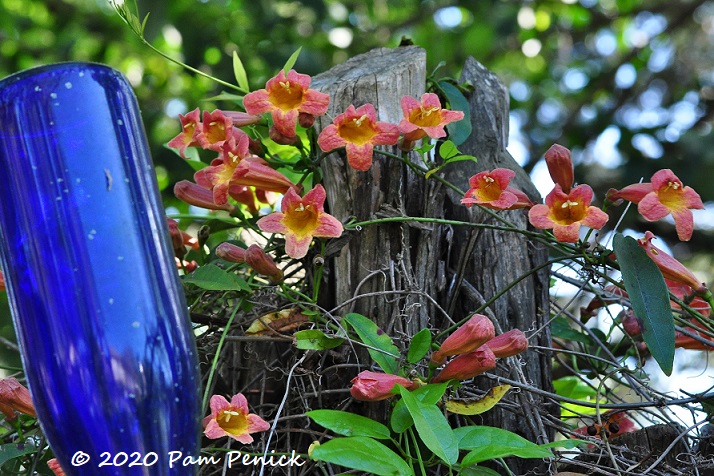
‘Tangerine Beauty’ crossvine rambles all along the length of the fence…
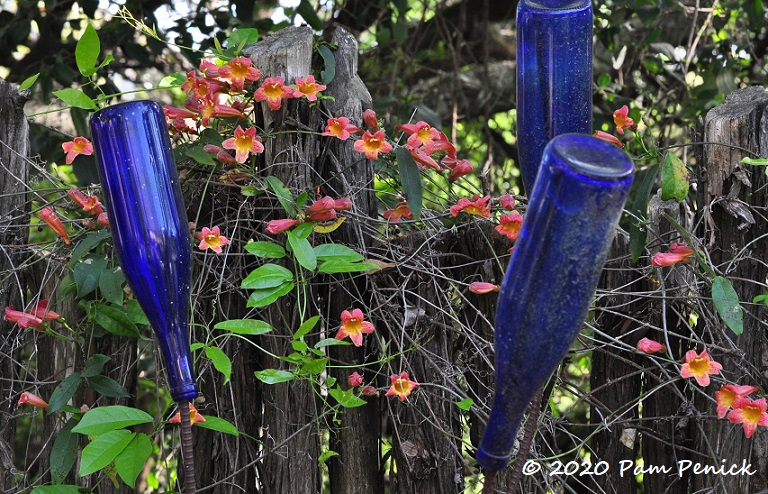
…keeping company with blue bottles on the bottle tree.
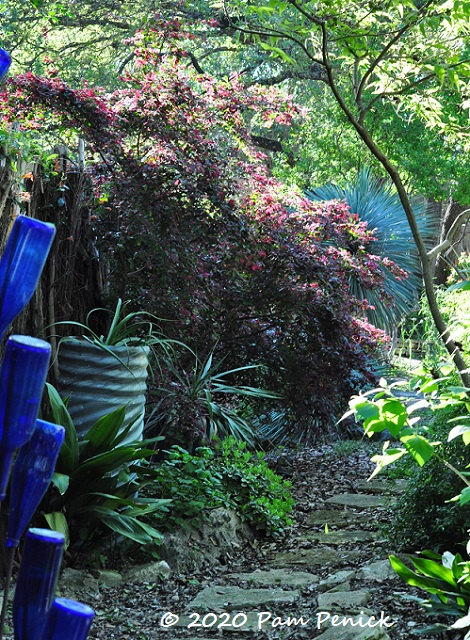
Looking lengthwise past the bottle tree, ‘Sizzling Pink’ loropetalum reappears, backed by a spiky blue fringe of Yucca rostrata.
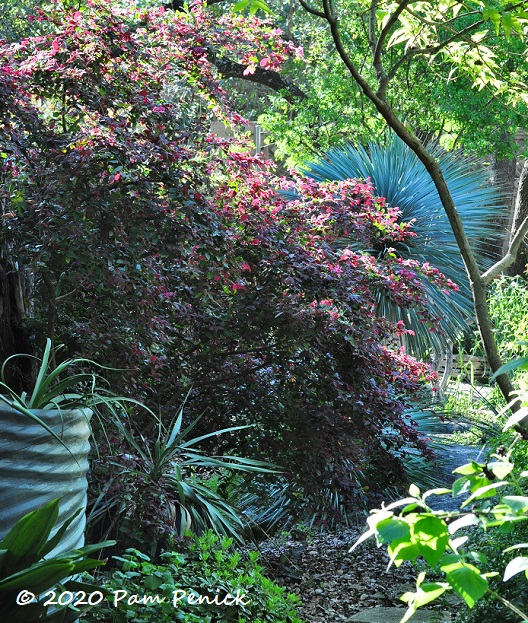
Still on my to-do list: lightly prune the loropetalum, which threatens to overrun the path.
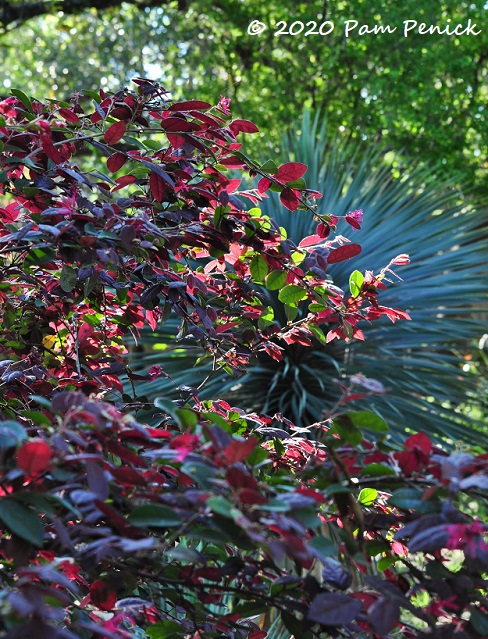
I adore those burgundy leaves as they catch the sunlight.
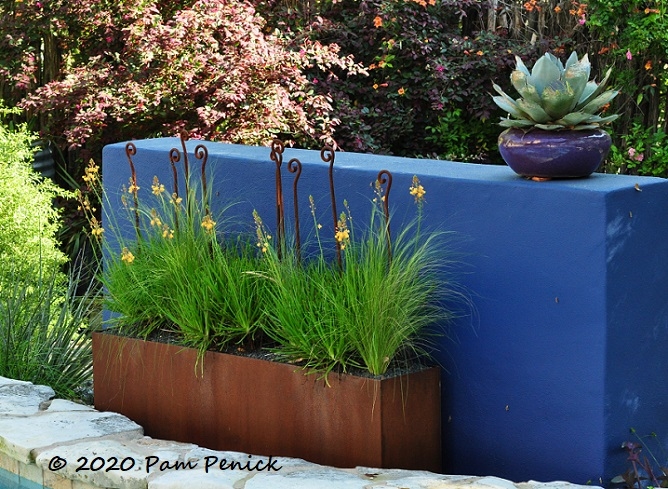
The loropetalum echoes the rusty steel planter in front of the blue wall. Orange bulbine has just started blooming again, mingling with the soft texture of Mexican feathergrass.
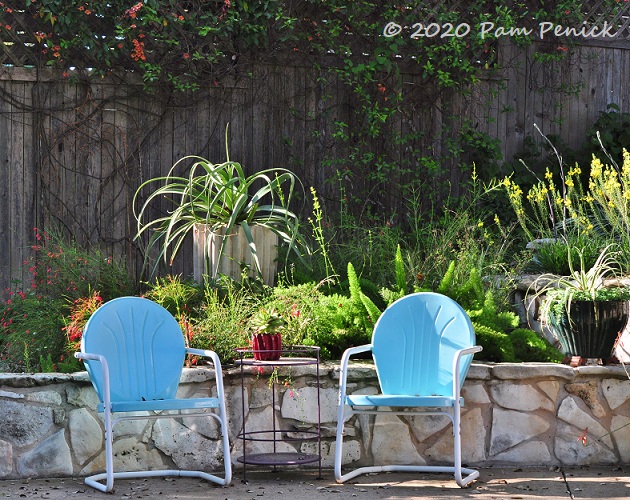
On the west end of the garden, the motel chair patio looks cheerful with a writhing squid agave (A. bracteosa) standing guard in a tall pot.
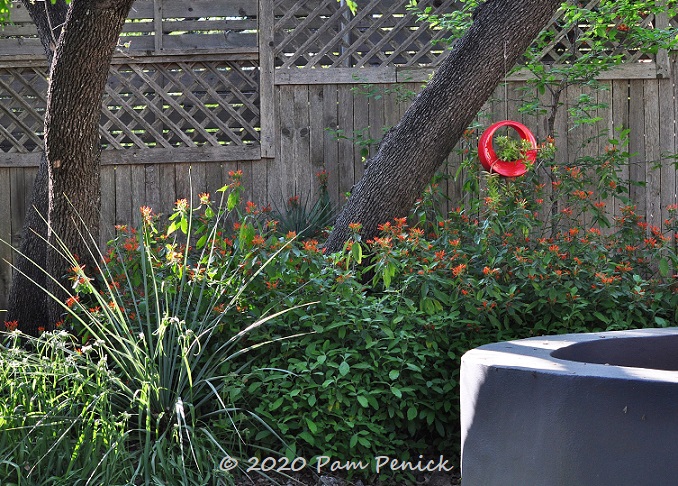
Panning left, a soft hedge of Mexican honeysuckle (Justicia spicigera) sends out its siren song to hummingbirds. Strappy blue nolina (Nolina nelsonii) emerges from a bunch of purple-flowering spiderwort (Tradescantia occidentalis), all closed up for the afternoon.
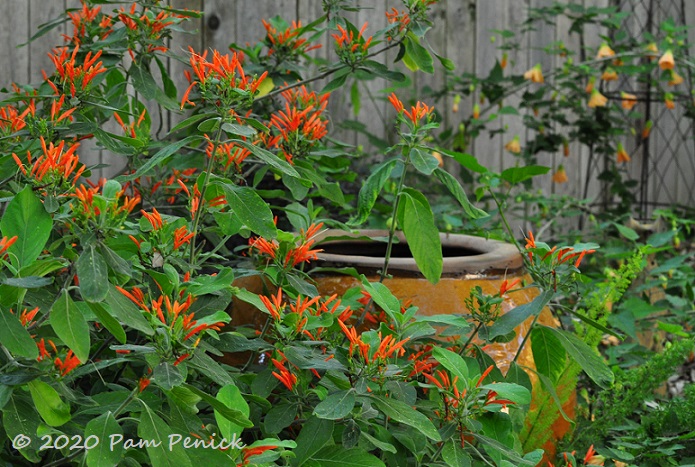
I love this combo of Mexican honeysuckle, an orange glazed pot, and ‘Bartley Schwarz’ abutilon.
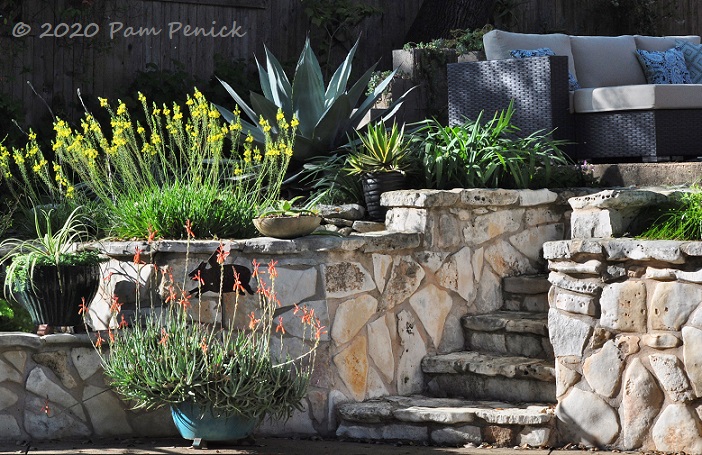
Panning right you can see my new outdoor sofa, perfect for lounging, on the upper patio, with whale’s tongue agave (A. ovatifolia) and yellow bulbine catching the afternoon sunlight.
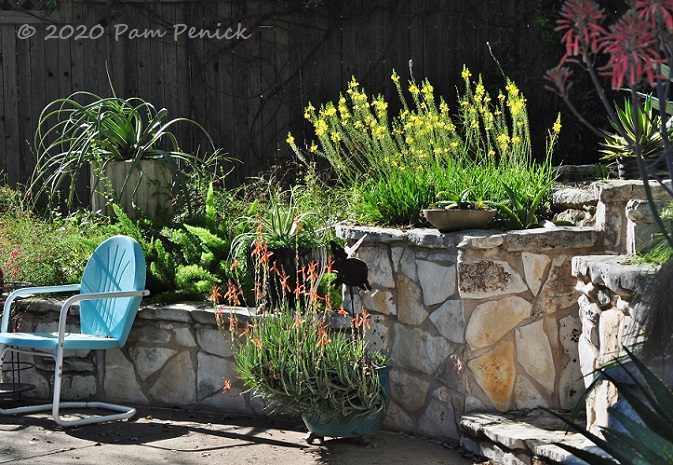
Potted up in front of the wall is ‘Blue Elf’ aloe, which I’ve had in this same pot for some 17 years. I periodically prune it back hard in late spring and let it come up afresh.
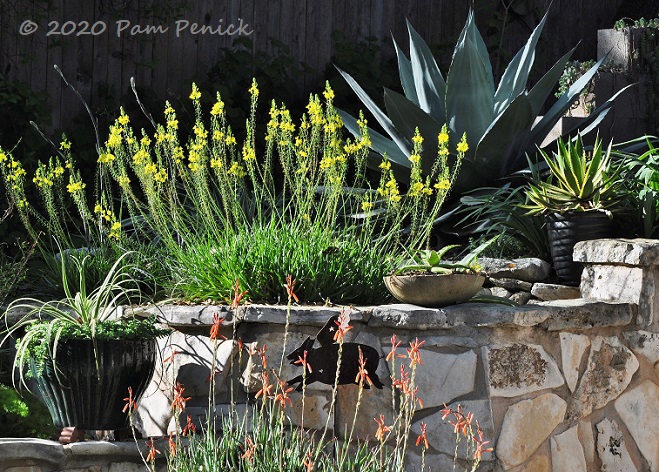
Sunny flower spikes!
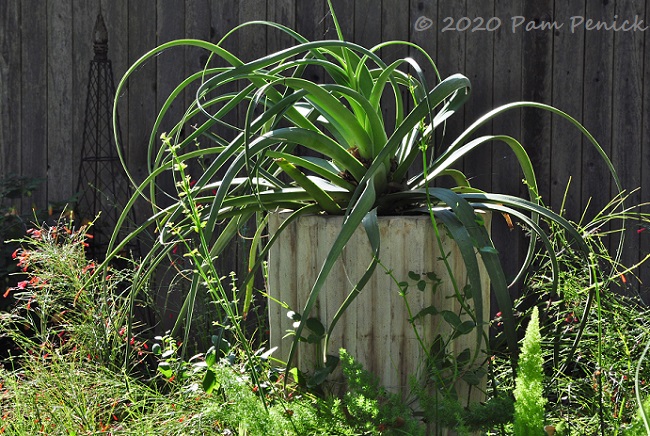
And more swirly squid agave arms.
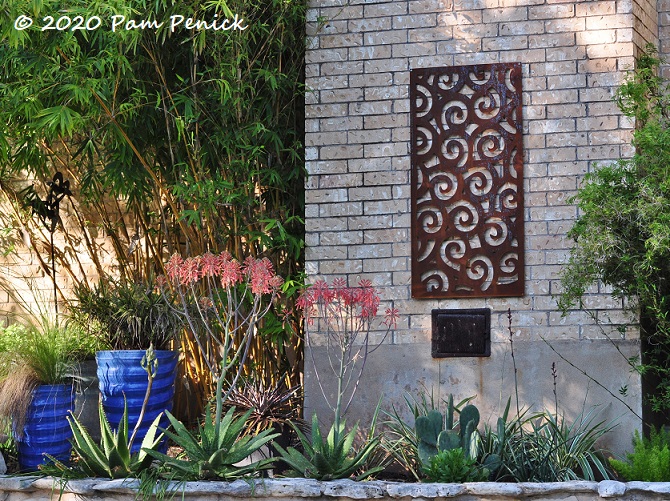
Behind the chimney, soap aloe (Aloe maculata) hoists its red candelabra flowers. Of course all I can see when I look at this view is an ‘Alphonse Karr’ bamboo that needs thinning and stripping. A task for another day.
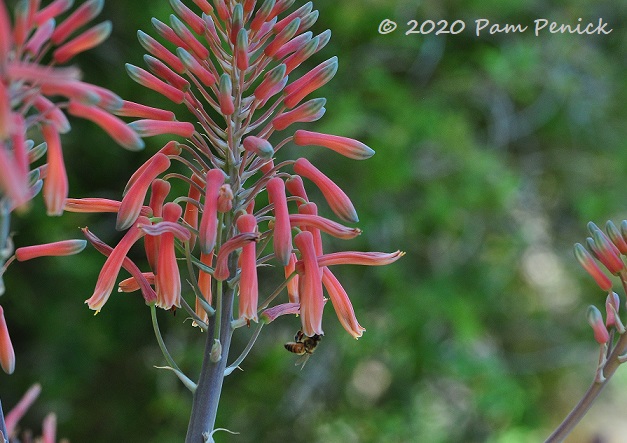
I’m also disturbed by a lack of honeybees in my garden this spring. Normally the spring garden would be buzzing with bees on Gulf Coast penstemon, spiderwort, and other spring flowers. This spring I’ve only seen a handful, including on the soap aloe, crawling way up inside the tubular blossoms.
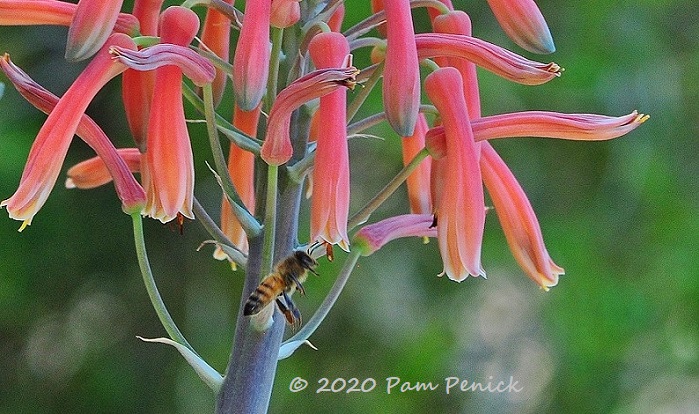
Here’s one cutie. But seriously, where are all the bees?
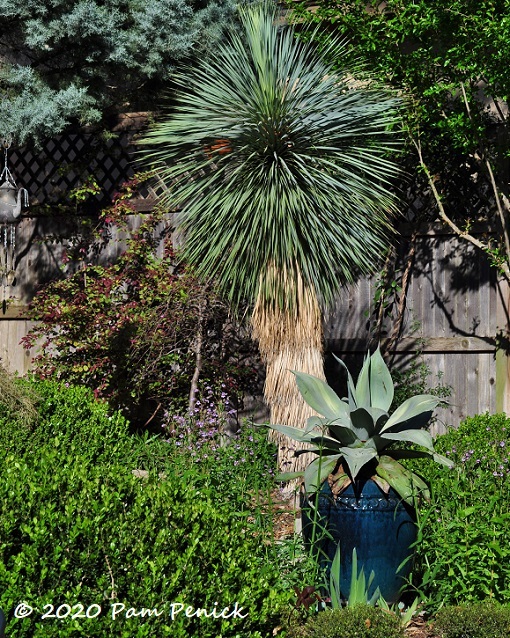
Looking across the garden toward my first Yucca rostrata ‘Sapphire Skies’, I notice how HUGE it’s getting. It’s developed a tall trunk with a grassy hula skirt, and it dwarfs the variegated whale’s tongue agave potted up in front of it.
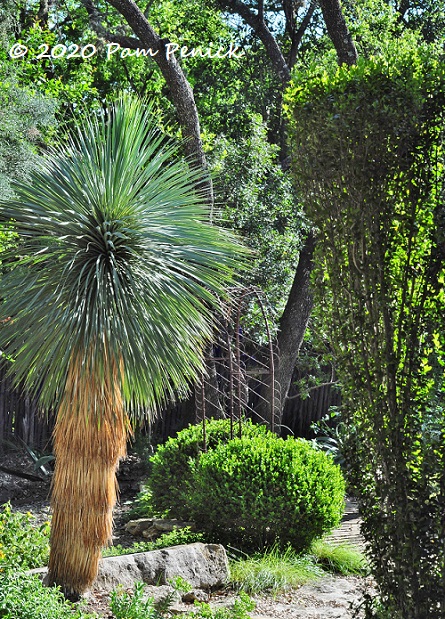
Here’s a different view, from up the hillside path. That’s a columnar ‘Will Fleming’ yaupon in the foreground at right.
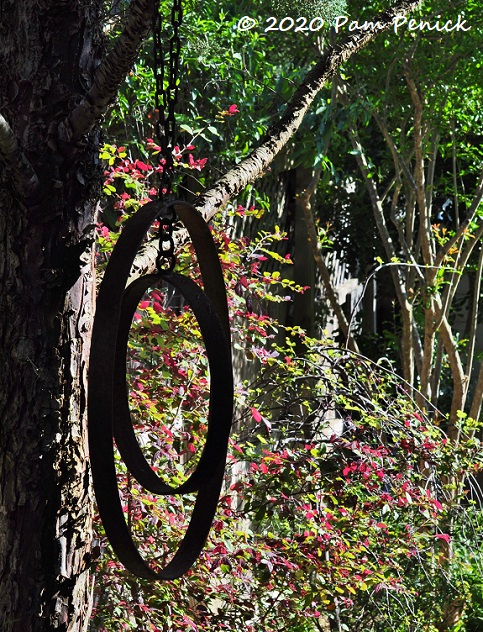
Metal hoops adorn a branch of an Arizona cypress, framing a view of another loropetalum.
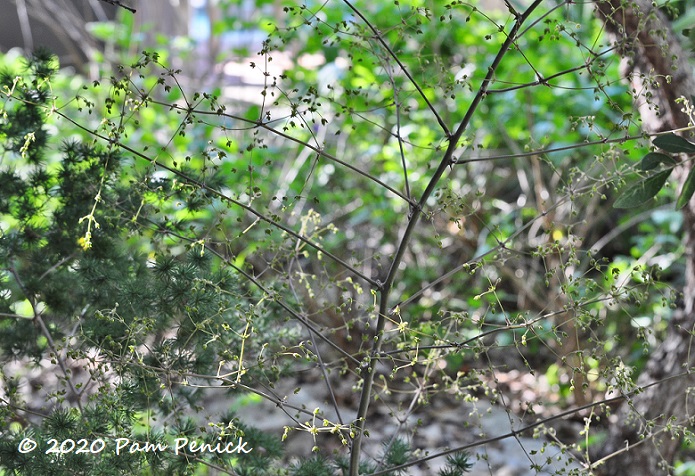
Here’s something I don’t think I’ve ever photographed: Ming fern’s airy flower stalk (Asparagus retrofractus).
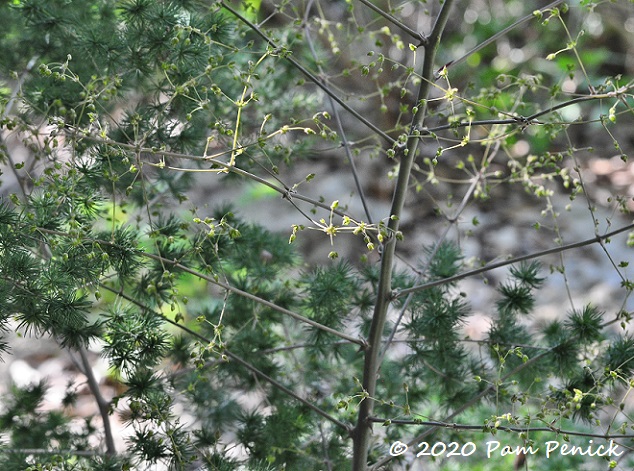
It’s quite pretty rising from Ming fern’s soft, conifer-like foliage.
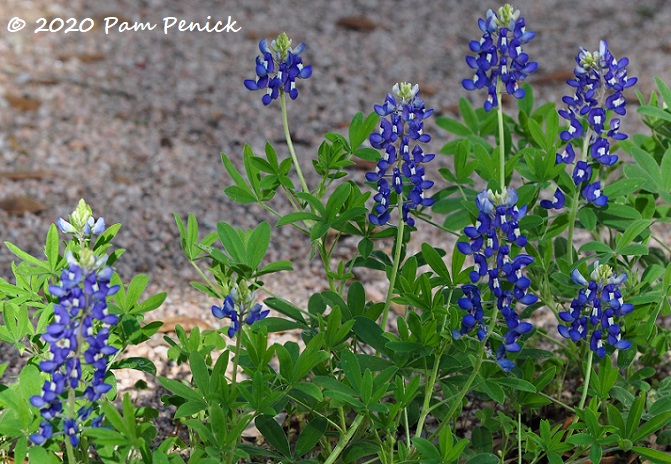
Now let’s head out front, where a few bluebonnets grow in the gravel path beside the driveway. These self-seeders have managed to avoid being trod on by Amazon delivery guys, and these days that’s saying something.
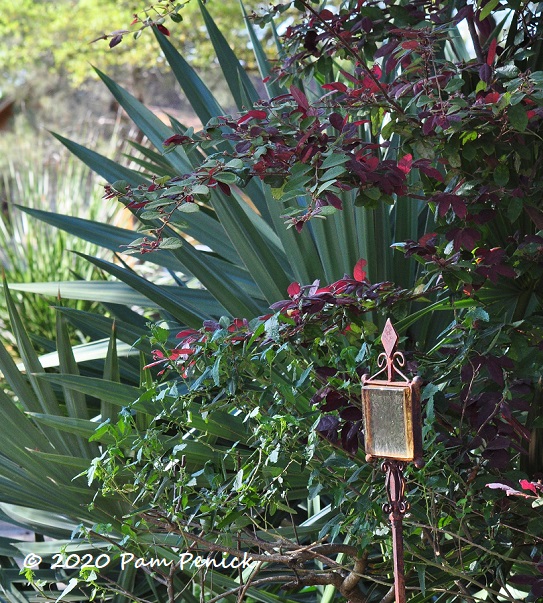
Yet another loropetalum (‘Rubrum’) adds its richly colored foliage to the Sabal minor palmettos in the island bed.
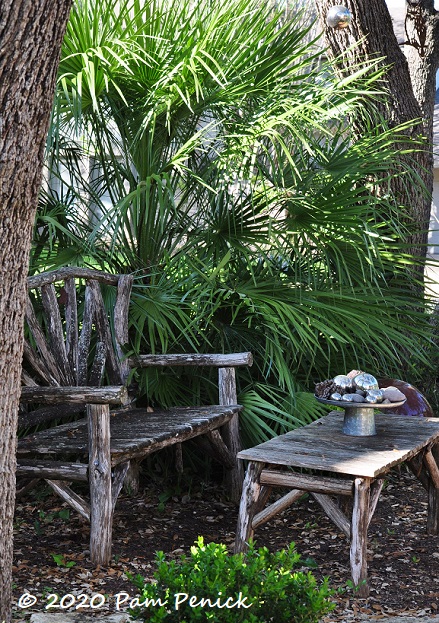
A side-yard cedar bench offers private seating behind an increasingly massive Mediterranean fan palm (Chamaerops humilis).
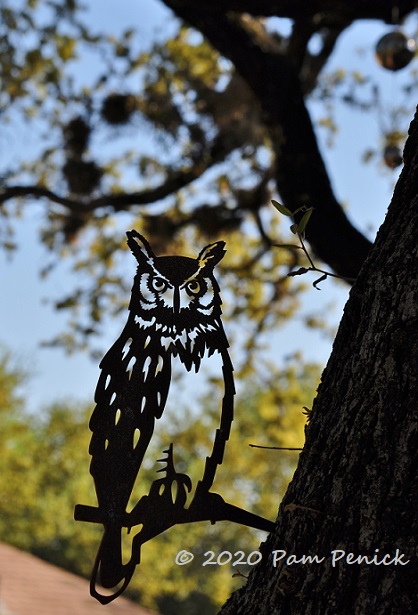
A metal great horned owl watches over the bench.
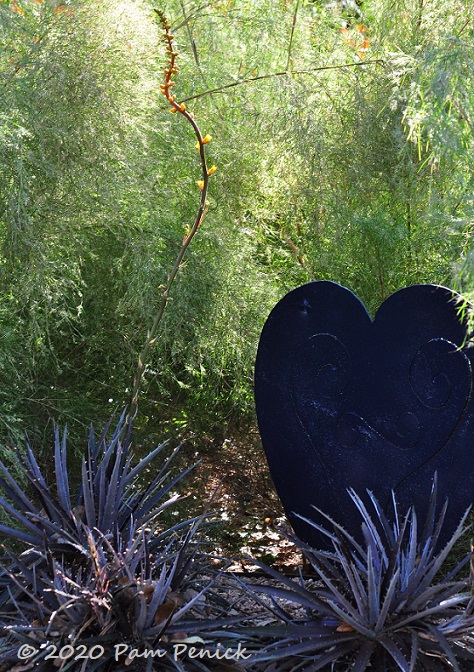
Our resident deer herd loves to nosh on yucca, hesperaloe, and dyckia bloom spikes, but somehow they missed this one.
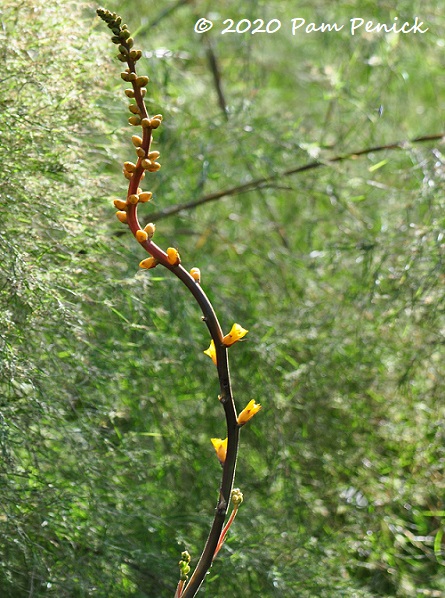
Its furry gold flowers open from the bottom up.
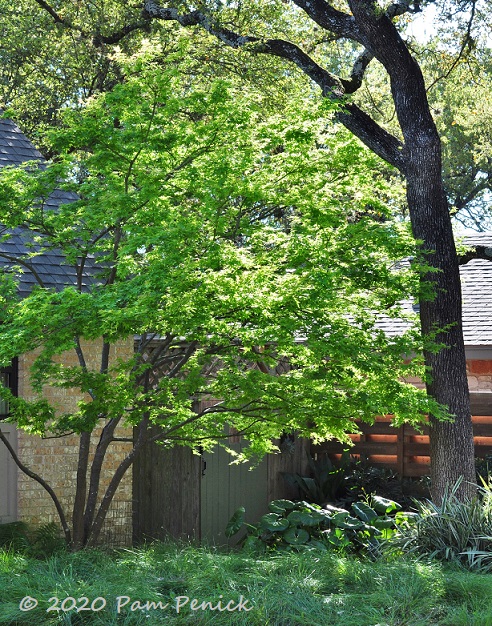
The Japanese maple (Acer palmatum), one of the few plants in my garden that I didn’t plant — has fully leafed out and now glows bright green.
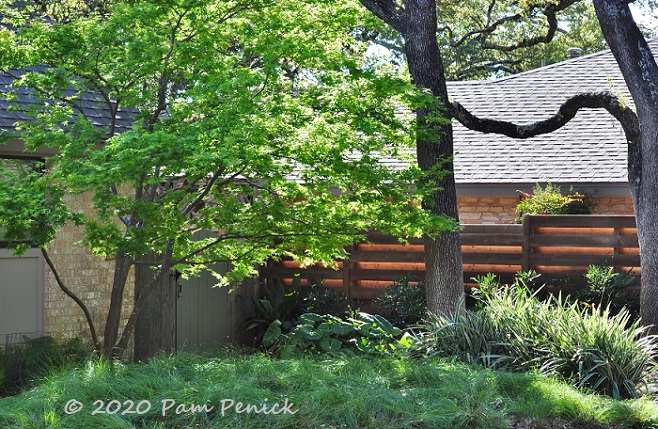
Combined with a meadowy sedge lawnette, giant leopard plant (Farfugium japonicum ‘Gigantea’), and variegated flax lily (Dianella tasmanica ‘Variegata’), it’s a study in green foliage and texture.
__________________________
Digging Deeper
Come learn about gardening and design at Garden Spark! I organize in-person talks by inspiring designers, landscape architects, authors, and gardeners a few times a year in Austin. These are limited-attendance events that sell out quickly, so join the Garden Spark email list to be notified in advance; simply click this link and ask to be added. Season 8 kicks off in fall 2024. Stay tuned for more info!
All material © 2025 by Pam Penick for Digging. Unauthorized reproduction prohibited.


Thanks for the beautiful pics. If one has to be social distancing, your garden is one of my top ten locations.
Aw, thanks, Jane. You’re always welcome here! 🙂
So many beautiful vignettes! Your yard is looking glorious. I haven’t tried growing lorapetalum yet, but you have me considering where I might place a couple; they look beautiful with the crossvine. Do you grow your Ming fern in the ground? I had an overly exuberant one break a ceramic pot recently, so for now I’ve repotted into a plastic pot that slips inside a larger ceramic one, but I’m wondering how much luck I might have putting it in a protected spot in the ground.
The Ming fern is growing in a holey rock, actually — a limestone boulder with a natural hole in the middle. It’s proven very drought tolerant in the shade.
Early spring looks fabulous in your garden.
Thanks, Hoov. Of course this morning the garden was covered in oak pollen catkins again.
Missing my tangerine beauty crossvine. It unexpectedly died along with a rose and a Southern wax myrtle–I’m guessing from the flash drought we had last year when I wasn’t clued in and wasn’t watering extra. Afterall–the grass was still looking good!
Regarding where are the bees?–the early freeze we had in October when so many nectar plants were blooming and then overnight, poof, no more–was so distressing. I knew that could not be good for our pollinators and hoped it wouldn’t manifest as a mass decline in the spring. Also didn’t know what impact that hot fall period had. We went from 100 degrees to freezing with barely any “fall temp” in between. However, I’m seeing a good amount of bee activity on pink salvia and bush germander in my yard right now. Peach trees saw good action while they were blooming, too. I had some flowering winter greens in my vegetable garden that were attracting a good amount of bees last month. So perhaps they have such a selection to choose from, they may be more dispersed than usual so there’s not a huge amount in any one place. I guess we could hope that’s the case. At any rate, the best we can do when Mother Nature throws whammy after whammy is to keep planting and keep growing nectar plants!
Thanks again for taking us along for the ride. Always nice to see other places and spaces!
I haven’t had much long-term luck with Southern wax myrtle myself. And roses are known to be finicky. But I’m surprised about the crossvine. It’s usually so dependable. And I’m glad you’re seeing lots of bees in your garden!
Your yard looks so inviting, our mild winter made for less recovery time in the garden. Seeing your pics made me realize that I should plant some palms, not the tall ones but the wide full type like yours. I definitely have loropetalum envy, but I have to add burgundy with grasses and alternanthera.
Your metal accents and colorful pots add so much personality, thanks for the tour!
It’s funny about the palms. I used to not care for any of them. Then slowly I came around to our native palmetto, Sabal minor, and then to the shrubby Mediterranean fan palms after seeing they could thrive even in shade. Having a shady garden makes you appreciate ALL the plants that can grow there. 😉
Your spiffy clean garden looks wonderful, Pam. I love the Bignonia-Loropetalum combination, which isn’t something I’d have thought of putting together. Your back-lit Bulbine make me miss mine, despite the pain I experienced getting them out when they engulfed an entire area of my garden when I wasn’t paying attention.
Winters here tend to knock bulbine back a bit, although mine have gone the last year or two with no damage.
I congratulate you on your excellent foresight: getting a new outdoor sofa to collapse upon after dealing with all the oak leaves – well done!
and of course, the garden looks fabulous as usual…I covet the giant leopard plant, since what I *thought* I purchased as giant seems to have been mistakenly tagged – unless one is gnome-sized…I long for tractor seats and have only achieved
bagels…:(
Bagels! I’m laughing out loud over your Lilliputian ligularia leaves. At least the garden gnomes will be happy for their new seating options.
Pam,
The bees must have all come to my Tangerine Beauty. The regular honey bees and the big black ones are all over it. I also have them on the Sweet Almond verbena tree and the Sweet Olives. Luckily, the Confederate Jasmine blooms later or it would be too much.
Haha, that’s great though! I’m glad they’re somewhere. 🙂
Gorgeous. Love that crossvine. I would like to get one going in my garden too. All of your hard work has paid off. All of your seating areas look so inviting.
Aw, thank you, Lisa. The seating is all a bit soggy right now, but I’m grateful for yesterday’s rain.
Looking fantastic as always, Pam! Two questions: What’s in the dark corner behind farfugium? Looks like agave but seems too dark. I’m looking for farfugium companions. Also, is the fan palm in a pretty shady spot? Does it function well as an understory palm?
Mexico pics were just beautiful, too. I’m enjoying your blog so much!
There’s a potted cast-iron plant, which is probably what looked a bit like agave leaves to you. And there’s a hedge of shade-loving Chinese mahonia. As for the Mediterranean fan palm, yes, it grows well in live oak shade — really well, in fact! Silver Mediterranean fan palm does too, but it grows much more slowly. Both need regular water for the first couple of years to get a good start. Sabal minor is a native understory palmetto and also does well in dry shade, with the caveat of needing regular water to get established.
I learned more in the past 5 minutes about local plant names than I have in the past 5 years wondering and then never liking them up!!! Gorgeous yard and plants…seriously, I’m soooo enamored with it ALL!!!! Good job!!!
You made my day with your comment, Haley. I’m so happy to be able to share via the blog what I’ve learned about plants and gardening here in Central Texas. Thanks too for your kind compliments!
I’ve got a question for you…Jasmine is a favorite of mine, not positive but I’m thinking star jasmine as I grew up a bit SW of here closer to the coast. As a little kid I thought it smelled like “suntan lotion” lol. In my old neighborhood in Houston, I could always smell it before I could even see it while out on walks, I’d round a corner and there’d be a fence or two absolutely covered in it. My question is, is it possible to grow in a pot??? I live in an apartment and I’d kill for a patio scented with jasmine!! I’ve learned that the version here is yellow and mostly unscented though I do see a white scented version sold at local nurseries and growing on fences, I’m too afraid to try it in a container.
Sure, it’s totally possible to grow star jasmine in a pot. I’d plant it in a pretty large pot to give it some root space as it grows, and it’ll need regular water in the hotter months (but less than if planted in a too-small pot). The white-flowered star jasmine is super fragrant and very common. You should be able to source it in most local nurseries right now.